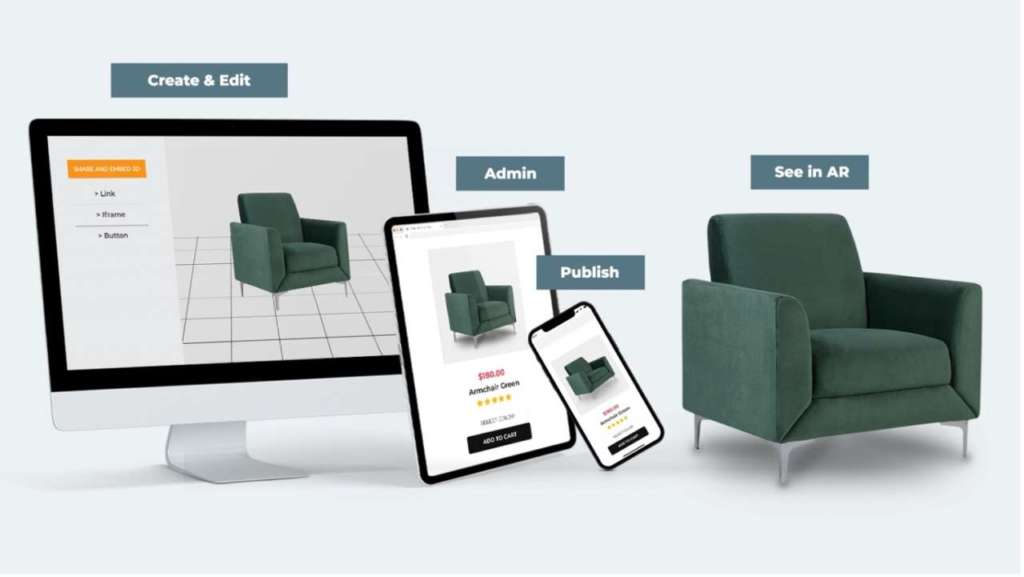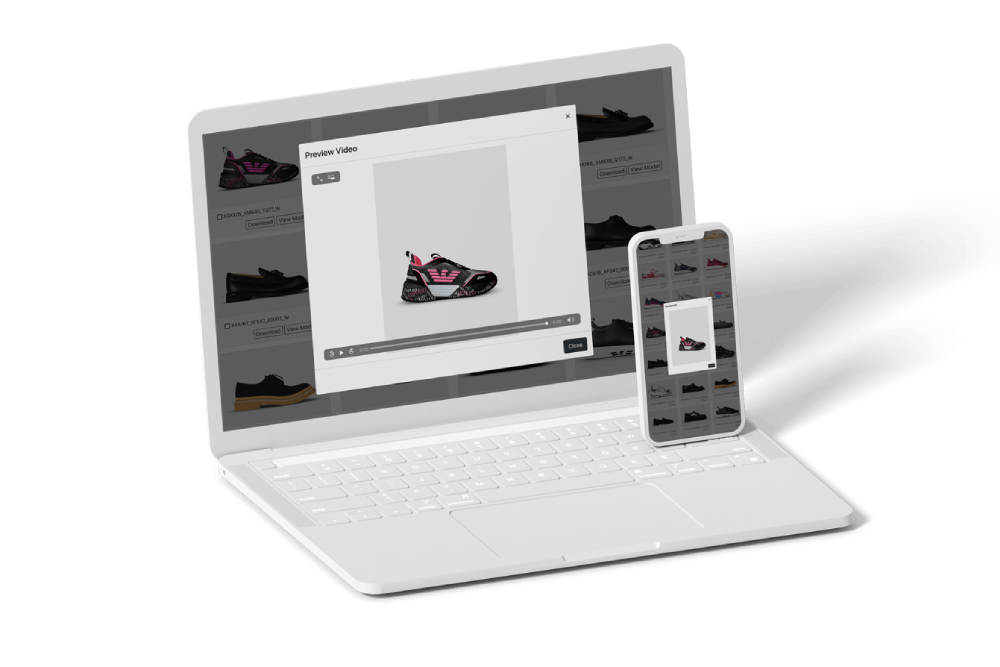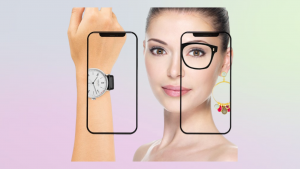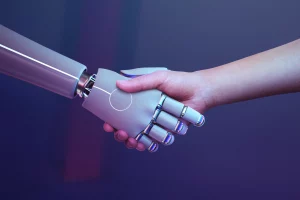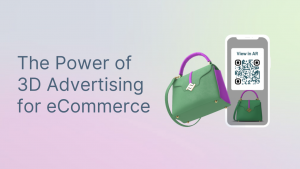As online shopping rises, the quest for visually appealing product presentations has never been more crucial so does the need for captivating and immersive product experiences. Enter the world of 3D product rendering – a game-changing technology that is revolutionizing the way businesses showcase and sell their products in the digital landscape.
Welcome to our comprehensive guide, where we delve into the thrilling realm of 3D product rendering and explore its transformative impact on e-commerce. Together, we’ll uncover the ins and outs of 3D render products, their benefits, and why they have become essential for businesses aiming to engage their audience.
What Is 3D Product Rendering?
Product 3D rendering, also known as 3D product visualization, is a process that uses specialized software to create photorealistic or non-photorealistic images from 3D models. This technique results in what is called a 3D render, which can showcase a product in various color variations, angles, environments, and views.
One of the main advantages of 3D rendering is the ability to visualize a product long before it is physically created. This feature allows marketers to plan ads in advance, enables manufacturers to see the product’s appearance, and allows brands to test the market through pre-selling. In the e-commerce sphere, 3D product rendering offers an indispensable tool for showcasing products in their best light.
How 3D Rendering Process Works
The 3D rendering process is a captivating blend of technical expertise and artistic creativity. It involves several stages, each essential in bringing a digital product to life with stunning visual appeal. Let’s explore the intricate steps that make the 3D rendering process possible.
Modeling
The foundation of the 3D rendering process lies in the art of modeling, where a 3D representation of an object is meticulously crafted using specialized software. During this phase, the size, shape, and appearance of the object are determined, setting the groundwork for the subsequent stages.
Texturing
The next step, texturing, involves infusing the 3D model with color, surface properties, and material attributes to authentically reflect the object’s overall appearance. This process adds depth and realism, crucial for captivating the viewer’s attention and imagination.
Lighting
Creating a realistic lighting setup within the 3D environment is pivotal. Carefully positioning and calibrating light sources to mimic real-world behavior elevates visual fidelity, injecting life and dimensionality into the digital creation.
Rendering
The culmination of the painstaking effort invested in modeling, texturing, and lighting is the rendering phase. Here, the 3D model and intricate lighting setup are transformed into a 2D image using sophisticated computer software, resulting in a snapshot that encapsulates the essence of the digital world.
Post-production
To polish the rendering and elevate its visual impact, thorough post-production is undertaken. Utilizing software like Adobe Photoshop or Lightroom, enhancements and adjustments are meticulously applied. These can range from adding motion blur and depth of field to incorporating lens flares, culminating in a visually captivating final image.
3D Product Rendering Cost
The cost of 3D product rendering can vary significantly depending on factors such as the product’s complexity, desired level of detail and realism, and the amount of work involved. For simpler projects, the cost can start from a few hundred dollars, while more complex projects can range into the several thousand dollar mark. When selecting a 3D rendering software, it’s crucial to weigh your budget against the desired quality level.
The Power of 3D Product Rendering: Applications and Use Cases
3D product rendering has become an integral part of various industries, providing numerous benefits and innovative opportunities.
Product Manufacturers
Product manufacturers utilize 3D rendering from the initial concept development phase to the production of marketing materials. This versatile technology allows them to visualize and finalize design ideas, enabling the approval of the final version of a product before it reaches the production stage.
E-commerce Platforms
E-commerce platforms have found immense value in 3D rendering, with some even requiring 3D models from vendors to create engaging photorealistic 3D product rendering or utilize Augmented Reality to showcase products. These 360 product views enhance the shopping experience for online consumers, providing a detailed and interactive view of the products.
Retail Companies
Retail companies benefit from the reusability of assets and the rapid generation of large batches of imagery without the need for physical transport. The integration of 3D rendering with AR and VR technologies has opened up new avenues for creating captivating product experiences.
Entrepreneurs
Entrepreneurs looking to swiftly introduce their products to the market have found 3D modeling and rendering to be invaluable. Through CGI, they can acquire high-quality visuals, lifestyle representations, and promotional videos even while their product is in transit or manufacturing, enabling them to launch websites and advertising campaigns while actively gathering funds through crowdfunding.
Marketing Agencies
Marketing agencies have been drawn to the time-saving benefits of 3D rendering, as they can obtain visuals before product manufacturing, facilitating efficient planning and strategy. Think also about the advantages of offering immersive 3D advertising that can really captivate customers. Moreover, the limitless creative opportunities offered by CGI enable them to showcase products from any angle and in diverse environments, empowering their campaigns with visually impactful content. Incorporating 3D rendering into their digital content plan allows agencies to stay ahead of the curve in engaging their audience with immersive experiences and cutting-edge visuals that resonate across various online platforms.
Photography vs. 3D Rendering: A Tale of Two Methods
When it comes to creating compelling visual marketing content for your products, the battle between product photography and 3D rendering continues to intensify. Both approaches offer distinct benefits and drawbacks, so it’s crucial to understand the nuances of each method before making a decision that aligns with your business goals.
Time
Product photography often involves elaborate, time-consuming processes such as organizing photoshoots, renting studios, and arranging transportation for product prototypes. On the contrary, 3D rendering streamlines the process with its digital nature, allowing for swift creation and modification of scenes and products.
The ability to produce multiple 3D models and renders simultaneously significantly accelerates production timelines in comparison to traditional photography methods.
Cost
The cost associated with product photography can quickly accumulate, encompassing photographer fees, studio rentals, prototype production, and transportation expenses. As the complexity of a photoshoot concept increases, so does the budget requirement. On the other hand, 3D rendering offers a more cost-effective alternative, as manufacturers only pay for the 3D artists’ working hours.
Some 3D studios even provide complimentary rounds of corrections within their service package, minimizing additional expenses. This affordability empowers businesses to achieve high-quality imagery within budget constraints, a feat that can be challenging with traditional photography.
Flexibility
While photo editing enables some degree of adjustment, it pales in comparison to the flexibility offered by 3D rendering. The digital nature of 3D rendering allows marketers and retailers to request updates at any stage of the rendering process, accommodating changes in product design or marketing concepts.
This ability to modify and refine imagery throughout the production process eliminates the need for time-consuming re-shoots or substantial post-production alterations, offering unparalleled flexibility in visual marketing.
Why Photorealistic 3D Product Rendering is Crucial for E-commerce
Traditional photography is often limited by budget constraints, inhibiting the execution of elaborate concepts and locations. Conversely, 3D rendering empowers creatives to bring any concept to life, regardless of budget limitations.
Whether it’s an opulent interior set or an exotic outdoor location, 3D rendering transcends physical constraints, delivering photorealistic imagery without transportation requirements or budgetary burdens.
The decision between photography and 3D rendering ultimately hinges on your specific business needs and creative aspirations. 3D rendering emerges as a formidable tool for businesses seeking to showcase their products with artistic freedom and cost-effective efficiency.
The ability to swiftly adapt to evolving design elements, creative concepts, and marketing strategies positions 3D rendering as a dynamic force in visual marketing, enabling businesses to stay agile and responsive in the ever-changing marketplace. Welcome to the 3D eCommerce era!
Zakeke: The Ultimate Solution for 3D E-commerce
Zakeke is the ultimate solution for businesses looking to create, manage, and share photorealistic 3D models of products at a low price point. It offers the most flexible and complete AI visual commerce platform, turning your store into an extraordinary customer experience with real-time 2D, 3D, AR, and virtual try-on customization.
With Zakeke, you can turn an ordinary shopping experience into something extraordinary in just seconds. By allowing your customers to create their dream products, you can engage them in a personalized and immersive shopping journey, enhancing product discovery and boosting conversions.
Zakeke’s 3D Digital Asset Manager lets merchants easily create 3D catalogs and Zakeke’s 3D Viewer allows merchants to share their 3D models everywhere, 100% code-free. Furthermore, merchants can offer live product customization in 3D, personalizing the shopping experience and making it more engaging.
Zakeke makes the 3D revolution accessible for all, today!

VEED
VEED is an online video editing platform that empowers creators to transform their videos with ease. With a team of skilled developers and video editing enthusiasts, VEED is revolutionizing the way people edit and enhance their video content. Through a user-friendly interface and a comprehensive suite of editing tools, VEED enables users to add captivating effects, captions, subtitles, and images to their videos effortlessly.

